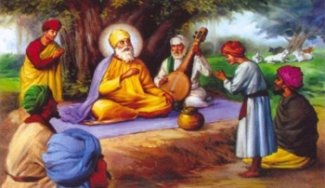A fulfilled life is one that is lived with a sense of purpose and meaning, where one is constantly striving to become a better person and make a positive impact on the world. In Sikhism, a fulfilled life is one that is lived with the understanding that everything comes from the divine and that one's actions should reflect this understanding. According to Sikhism, it can be achieved by following the doctrine of Naam, Daan, and Isnaan. These are three essential aspects of the Sikh way of life and are deeply rooted in the teachings of the Sikh Gurus. These three principles are often referred to as the "Three Pillars of Sikhism" and are seen as important aspects of spiritual and ethical living for Sikhs, leading to a fulfilled life for the devotees.
Introduction
Everyone aspires to live a life that is rich in meaning, purpose, happiness, contentment, and satisfaction. Such a fulfilled life brings us closer to our true selves and a deeper understanding of our place in the world. It helps us to grow and develop as individuals and to reach our full potential. By living a life guided by our values and beliefs, we can overcome obstacles, face challenges, and achieve our goals. This sense of achievement and growth can bring deep satisfaction, inner peace, contentment, and joy to our lives. A fulfilled life also helps us to cultivate positive relationships with others and to feel connected to the community and the world at large. Moreover, when we engage in service, kindness, and compassion towards others, we help those in need and positively impact the world.
In Sikhism, a fulfilled life is one that is lived with the understanding that everything comes from the divine and that one's actions should reflect this understanding. A fulfilled life is one that is lived with a sense of purpose and meaning, where one is constantly striving to become a better person and make a positive impact on the world. According to the Sikh way of life, it can be achieved by following the doctrine of 'Naam,' 'Daan,' and 'Isnaan'. Sikh Gurus emphasize this principle in their hymns [1-2]:
ਗੁਰਮੁਖਿ ਨਾਮੁ ਦਾਨੁ ਇਸਨਾਨੁ ॥
Gurmukẖ nām ḏān isnān.
The Guru-Oriented seekers receive the wisdom of meditation, charity, and cleansing (Naam, Daan, Isnaan) to attune to the blissful state. (M. 1, SGGS, p. 942)
ਨਾਮੁ ਦਾਨੁ ਇਸਨਾਨੁ ਦਿੜੁ ਸਦਾ ਕਰਹੁ ਗੁਰ ਕਥਾ ॥
Nām ḏān isnān ḏiṛ saḏā karahu gur kathā.
Confirm your faith in meditation, charity, and self-purification (Naam, Daan, Isnaan), and always use these topics for exegeses. (M. 5, SGGS, p. 1101)
'Naam' helps to connect with the divine and achieve inner peace. 'Daan' assists to create a positive influence on the world around us, and 'Isnaan' supports maintaining good physical and mental health [3-5]. Together, these practices can lead to a life rich in meaning, purpose, and fulfillment. Let us know how these concepts help us to cultivate a sense of spirituality, compassion, discipline, and gratitude leading to a fulfilled life.
Naam (Meditation on God)
In Sikhism, "Naam" refers to the divine Name of God. It is the essence of God and the foundation of spiritual practice in Sikhism [3]. According to Sikh teachings, meditating and reflecting on Naam can lead to a deeper connection with God, inner peace, and spiritual growth. The Naam is often described as a powerful tool for purifying the mind and soul and attaining blissful consciousness. Guru Arjan Dev emphasizes the importance of Naam in his hymns:
ਮਿਲੁ ਸਾਧਸੰਗਤਿ ਭਜੁ ਕੇਵਲ ਨਾਮ ॥
Mil sāḏẖsangaṯ bẖaj keval nām.
Join the holy congregation and meditate only on God (Naam). (M. 5, SGGS, p 12)
The most used Naam in Sikhism is "Waheguru," which means "Wonderful Teacher" or "Wonderful Lord." Sikhs believe that the constant remembrance of Waheguru can bring them closer to the divine and help them live a more meaningful and fulfilling life. In Sikhism, Naam is not just a concept or a word but a powerful spiritual practice that can lead to a direct experience of God. It is believed that by contemplating the Naam with a pure heart and a focused mind, one can connect with the divine and experience its presence within oneself.
Sikh scriptures describe Naam as a divine light that shines within every living being and as a way to relate with the ultimate reality. Therefore, the practice of Naam Simran, which involves the repetition of or reflecting on the divine Name, is considered a central part of Sikh spiritual practice. In addition to Waheguru, other names of God are also used in Sikhism, such as Satnam (True Name), Akal Purakh (Eternal Being), and Ek Onkar (One God). All of these names point to the same ultimate reality: the source and sustainer of all creation.
Thus, Naam, a fundamental concept in Sikhism, is considered a key to unlocking the spiritual potential of human beings. By practicing Naam, Sikhs seek to develop a deeper understanding of themselves, their world, and the divine nature of all existence.
Daan (Charity)
In Sikhism, "Daan" refers to donating to those in need [4]. Daan is deeply ingrained in Sikhism and is seen as a method to express thankfulness to the divine for the blessings one has received. It is also considered a way to fulfill one's social and moral responsibility toward the community and the less fortunate [6-8].
Sikhs are encouraged to practice Daan in various forms, including donating money, food, clothing, or other material possessions to those in need. Daan is not limited to just giving to those who are poor or needy but also extends to supporting religious institutions, education, and other causes that benefit society. Guru Nanak emphasizes the importance of daan (Charity) in his hymns:
ਘਾਲਿ ਖਾਇ ਕਿਛੁ ਹਥਹੁ ਦੇਇ ॥ਨਾਨਕ ਰਾਹੁ ਪਛਾਣਹਿ ਸੇਇ ॥
Gẖāl kẖā▫e kicẖẖ hathahu ḏe▫e. Nānak rāhu pacẖẖāṇėh se▫e.
A person, who earns his living honestly and shares his earnings with others, Nanak says, knows the Path of righteousness. (M. 1, SGGS, p. 1245)
In Sikhism, Daan is not just seen as a practice to help others but also as a technique to purify one's soul and cultivate selflessness and generosity. In addition, the practice of Daan is seen as an important approach to developing a sense of compassion, empathy, and connection with others.
In Sikhism, the practice of Daan is also closely linked to the concept of Seva, which refers to selfless service for the benefit of others. Seva is a crucial aspect of Sikhism and is seen as a method to express love and devotion to the divine.
Sikhs are encouraged to practice Seva and Daan in all aspects of their lives and to make them a part of their daily routine. It can include volunteering at a local charity or food bank, donating to a worthy cause, or helping a needy neighbor. The Sikh Gurus themselves set an example of practicing Daan and Seva. They emphasized the importance of serving others and giving selflessly and encouraged their followers to do the same.
The Sikh community has a long tradition of running charitable institutions, such as hospitals, schools, and langars (free community kitchens), which provide services to those in need despite their background or beliefs. In Sikhism, the practice of Daan is not just about giving material possessions but also about giving one's time, energy, and skills for the benefit of others. Thus, charity is encouraged among Sikh devotees to develop a sense of humility, gratitude, and compassion and to live a life of service and purpose.
Isaan (Cleansing)
In Sikhism, "Isnaan" refers to the act of bathing or cleansing oneself, both physically and spiritually [5-7]. It is another essential aspect of Sikh practice. It is seen as a method to purify the body and mind to prepare oneself for spiritual practice and worship. Isnaan is not just about physical cleanliness but also about inner purification.
Sikhs believe that the body and mind are interconnected, and physical cleansing can help to cleanse the mind and prepare it for spiritual practice. Therefore, the practice of Isnaan is an integral part of the Sikh daily routine. It involves bathing or showering, washing hands and feet before entering a place of worship, and keeping oneself clean and presentable. It is also common for Sikhs to take a dip in a natural body of water, such as a river or lake, as a form of physical cleansing.
Isnaan is also an essential aspect of Sikh ceremonies and rituals. For example, before entering the Golden Temple, the holiest shrine of Sikhism located in Amritsar, India, Sikhs must wash their hands and feet and cover their heads as a sign of regard and humility. Similarly, before the Sikh baptism ceremony, known as Amrit Sanchar, the participants undergo a ceremonial bath as a form of physical purification and preparation. Guru Arjan Dev urges us to take the cleansing bath:
ਨਿਰਮਲ ਹੋਏ ਕਰਿ ਇਸਨਾਨਾ ॥
Nirmal ho▫e kar isnānā.
One becomes immaculately pure, on taking the cleansing bath. (M. 5, SGGS, p. 625)
Besides physical cleansing, Ishnaan involves spiritual cleansing through reciting prayers and the repetition of the divine Name. Sikhs believe that reciting prayers and meditating on the Holy Name can purify their mind and soul and connect them with the sacred. Isnaan is also seen to cultivate discipline and self-control. By making Isnaan a regular part of their routine, Sikhs develop a sense of personal responsibility and self-discipline and learn to prioritize physical and spiritual cleanliness. Guru Nanak elaborates on another aspect of Isnaan (cleansing):
ਗੁਰਮੁਖਿ ਮਜਨੁ ਚਜੁ ਅਚਾਰੁ ॥
Gurmukẖ majan cẖaj acẖār.
The Gurmukh's cleansing bath is the performance of good deeds. (M.1, SGGS, p. 932)
In Sikhism, the practice of Isnaan is also closely linked to the concept of Hukam, which refers to the divine order or command. Sikhs believe that by submitting themselves to the divine order, they can purify themselves and become closer to God. Isnaan is seen as a way to surrender oneself to the divine order and to prepare oneself to receive divine grace and blessings. A healthy body and mind are essential for living a fulfilling life, so by practicing Isnaan, we can develop a sense of discipline and self-control and maintain good physical and mental health.
Some Daily Practices to Follow Naam, Daan, and Isnaan Doctrine
In Sikhism, a fulfilled life is one that is lived following the teachings of the Sikh Gurus, leading to spiritual growth, inner peace, and service to others. Here are some ways to live a fulfilled life in the Sikh way:
- Follow the teachings of the Gurus: To live a fulfilled life, one must follow the teachings of the Sikh Gurus and seek to apply them in one’s daily life. It involves studying the holy scriptures, meditating on God's name (Naam), and practicing humility, compassion, and service.
- Serve others: Sikhs believe serving others is a way to serve God. Therefore, to live a fulfilled life, one must engage in selfless service (Daan) to others and contribute to the community's welfare. It can be done through charity, volunteering, or supporting social causes.
- Practice honesty and hard work: Sikhs believe in earning a living through hard work, dedication, and honesty. Therefore, to live a fulfilled life, one must work hard and earn a living honestly while also being mindful of the impact of one’s work on others.
- Live a balanced life: To live a fulfilled life, one must seek to balance one’s spiritual, social, and personal lives. It involves setting aside time for prayer and meditation while engaging in social activities and personal interests.
- Cultivate inner peace: To live a fulfilled life, one must strive to cultivate inner peace through meditation, prayer, and self-reflection (Isnaan). It involves focusing the mind on God's name, renouncing negative thoughts and emotions, and embracing a positive and peaceful outlook.
Conclusion
Sikhism teaches that a fulfilled life is one that is lived with a sense of purpose, compassion, and service to others while remaining connected to the divine through prayer and meditation. To do this, Sikhs are encouraged to live a life of service, honesty, compassion, and humility. They are also expected to work hard, share their wealth with others, and engage in meditation and prayer to connect with the divine. Guru Arjan Dev articulates these ideas in his hymns:
ਦ੍ਰਿੜੁ ਨਾਮ ਦਾਨੁ ਇਸਨਾਨੁ ਸੁਚਾਰੀ ॥ਕਹੁ ਨਾਨਕ ਇਹੁ ਤਤੁ ਬੀਚਾਰੀ ॥
Ḏariṛ nām ḏān isnān sucẖārī. Kaho Nānak ih ṯaṯ bīcẖārī.
Enshrine the Naam within oneself, with charity, true cleansing, and righteous conduct. Nanak urges us to contemplate this essence of reality. (M. 5, SGGS, p. 740)
References
-
Sri Guru Granth Sahib, (SGGS), 1983 (Reprint), SGPC, Amritsar. India.
-
Sant Singh Khalsa, English translation of Sri Guru Granth Sahib, http://www.srigranth.org/servlet/gurbani.gurbani?S=y
-
Harbans Lal, Seeking Wisdom - A Blog: Three Pillars for a Fulfilled Life Part 1: Naam – A Password for Universal Reality, June 21, 2017
https://seekingwisdomblog.wordpress.com/2017/06/21/naam-password-for-uni...
-
Harbans Lal, Seeking Wisdom - A Blog: Three Pillars for a Fulfilled Life Part 2: Daan – Altruism, July 16, 2017
https://seekingwisdomblog.wordpress.com/2017/07/16/daan-altruism/
-
Harbans Lal, Seeking Wisdom - A Blog: Three Pillars of a Fulfilled Life Part 3: Ishnaan – The Ethics of Good Deeds, July 30, 2017. https://seekingwisdomblog.wordpress.com/2017/07/30/three-pillars-of-a-fu...
-
D. P. Singh, A Path to Truthful Living (Part-II), The Sikh Review, Vol. 67:2, Feb. 2019, 19-30.
-
D.P. Singh, A Path to Truthful Living (Part-I), The Sikh Review, Vol. 67:1, Jan. 2019, 25-32.
-
D.P. Singh, Science and Sikhism - Conflict or Coherence, Singh Brothers, Amritsar, India. 2018











